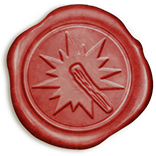
Improvised damage is a way to figure out how much damage a nonstandard weapon or attack might do. This can be used for anything that deals damage but wouldn’t have a set amount applied to it in the rules or books.
| Dice | Examples |
|---|---|
| 1d10 | Examples: Burned by coals |
| Examples: Hit by a falling bookcase | |
| Examples: Pricked by a poison needle | |
| 2d10 | Examples: Being struck by lightning |
| Examples: Stumbling into a fire pit | |
| 4d10 | Examples: Hit by falling rubble in a collapsing tunnel, stumbling into a vat of acid |
| Examples: Stumbling into a vat of acid | |
| 10d10 | Examples: Crushed by compacting walls |
| Examples: Hit by whirling steel blades | |
| Examples: Wading through a lava stream | |
| 18d10 | Examples: Being submerged in lava |
| Examples: Being hit by a crashing flying fortress | |
| 24d10 | Examples: Tumbling into a vortex of fire on the Elemental Plane of Fire |
| Examples: Being crushed in the jaws of a godlike creature or moon-sized monster |
A dungeon master needs to be careful not to cause excessive improvised damage to a low level party. The table below provides a guideline to how deadly damage can be for characters of various levels.
| Dice | Examples | ||
|---|---|---|---|
| 1st–4th | Examples: 1d10 | 2d10 | 4d10 |
| 5th–10th | Examples: 2d10 | 4d10 | 10d10 |
| 11th–16th | Examples: 4d10 | 10d10 | 18d10 |
| 17th–20th | Examples: 10d10 | 18d10 | 24d10 |